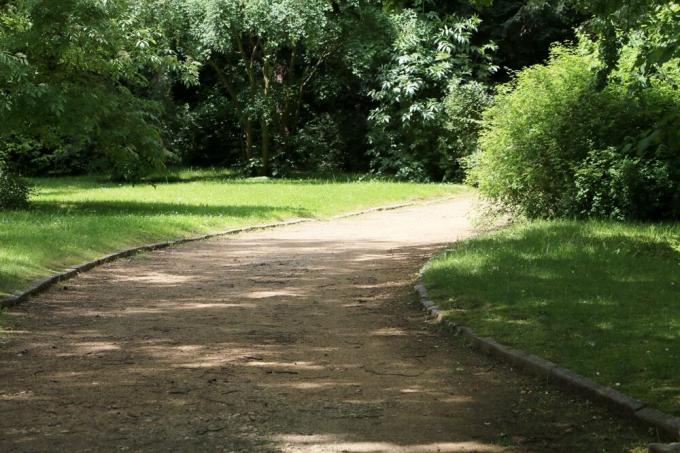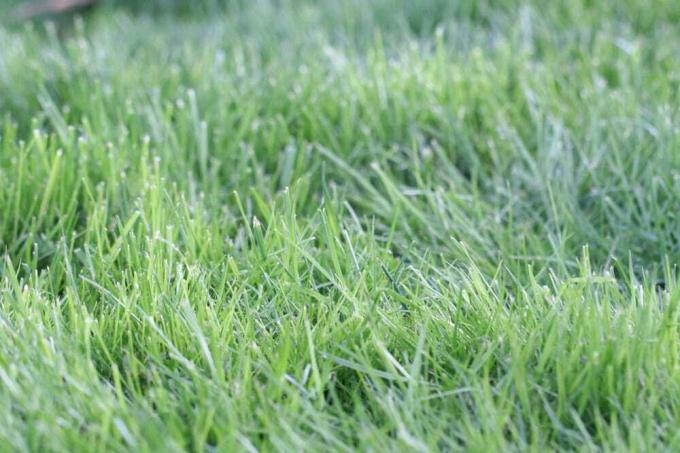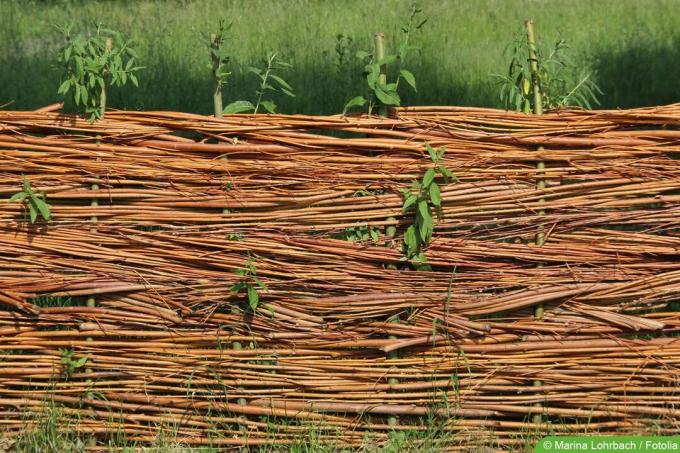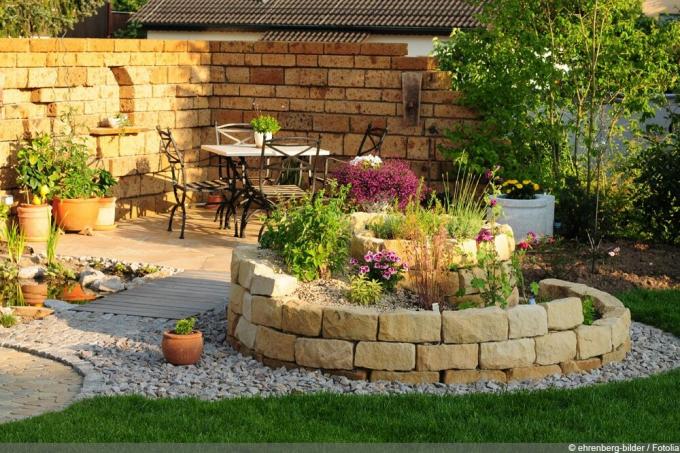

Table of contents
- material
- Instructions
- Dimensions
- weights
- Prices
- alternatives
Lawn borders decoratively and practically keep the grass in check and facilitate the design of accurate paths and grass-free beds. How they are set and what dimensions and weights are available is revealed here as well as how the prices of the lawn edging stones and possible alternatives to the classic fixed and rectangular ones Shape.
material
Placing a lawn border is easy in itself, but requires the appropriate accessories in addition to the lawn edging stones themselves. This includes:
- concrete
- board
- thread and rods
- fine gravel
- Rubber mallet or hammer and board
- spade
- level
- folding rule
These aids and tools are necessary to set the lawn borders straight and safe without damaging the stones.
Instructions
If solid stone or concrete lawn borders are to be set, various steps are required. The process is as follows.
- Stretch a string as a guide along the desired lawn edge and dig a narrow trench under this guide. As an additional aid, a board can also be placed on the ground to get a straight edge and make digging the trench easier. The trench should be about three times the width of the turf borders and about one-third to one-half the height of the turf borders. A folding rule is an easy way to check that the depth of the trench is even.
- The inside of the ditch is compacted with a board, batten or bricks according to the width of the ditch. To do this, a straight tool is inserted and lightly tapped with a hammer or stone so that the ground is as flat as possible.
- Either concrete or fine gravel is then poured into the trench. Concrete should be used when setting heavy and high turf soil as it provides a more stable base. Gravel is sufficient for low and light lawn edges, but even then it does not offer guaranteed protection against the stones tipping over – for example, if the lawn mower accidentally hits them becomes.
- The lawn borders are now inserted into this bed of concrete or gravel. Again, the string should be used as a guide to allow for straight alignment. The spirit level is used to check the horizontal alignment. If necessary, the lawn edging stones can be driven deeper into the still wet concrete or gravel with a rubber mallet or a board placed on top and an ordinary hammer.
- Once the lawn edging stones are aligned as desired, the side of the trench can be filled with concrete or gravel to give the edges additional stability. The top cover can be made of gravel or earth, depending on your visual desires. When covering with soil, care should be taken to ensure that the lawn is of a suitable height so that the lawn can finally grow to the edge.
Tip:
Lawn borders with tongue and groove are easy to align, as the stones interlock and are therefore more stable when set in a row.
Dimensions

Classic lawn borders made of stone or concrete are usually 50 or 100 centimeters long. In the case of corner stones or angles, however, the length dimensions can deviate. When it comes to height, there is more leeway. 15, 20, 25 and 40 centimeters are common. A similarly large spectrum can be found in width and depth. From narrow 1.5 centimeters to 5 and 6 centimeters to wide 8 or even 10 centimeters are common. However, other dimensions can also be found in the large range.
In addition to the look, the intended use is also decisive in the selection. If a bed with taller plants is to be separated from the lawn or if the border is to border a raised path or a gravel path, higher lawn borders make sense. If it is just a matter of delimiting the lawn from a stone path or a low bed, low lawn borders are sufficient. These are also less of a tripping hazard - but are also more easily "run over" with the lawnmower.
weights
The weight of a lawn curb depends of course on the dimensions and the material. A lawn border made of concrete with a thickness of 5 centimeters, 25 centimeters high and 100 centimeters long weighs around 30 kilograms. If, on the other hand, the lawn board is made of granite, the weight can be 40 kg or more with the same dimensions.
The heavier the lawn borders are, the more stable the base must be to prevent the stones from sinking in. In addition, heavy lawn edging stones are also more difficult to set and the effort and costs of transport.
Prices
The price for lawn borders depends on the dimensions and the material as well as the number and the transport. Narrow, small lawn borders made of concrete are already available for less than two euros. Variants made of concrete with tongue and groove, in larger dimensions or decorative colors usually cost less than five euros. Matching corner stones or angle stones are somewhat more expensive.
Here are some concrete examples from the OBI hardware store:
- Gray concrete lawn border, 100 x 25 x 5 cm – EUR 1.59
- Matching corner stone in gray concrete, 25 x 25 x 5 cm - €6.49
- Brown concrete lawn border, 100 x 25 x 5 cm – 2.29 EUR
- Matching brown concrete cornerstone 25 x 25 x 5 cm - €7.29
For a lawn border in gray there are just 1.59 euros per meter. If the concrete lawn edge is to be brown, on the other hand, it is at least 2.29 euros per meter. For a rectangular shape, there is an additional 25.96 euros for corner stones in the gray version. The brown variant, on the other hand, costs 29.16 euros.
Completely different price relationships can be found with lawn borders made of granite or other natural stone, with granite being the most common next to concrete. There is no lawn border for less than ten euros. The upper spectrum - for example for very large widths or special colors - moves between 50 and about 70 euros per straight lawn edge stone.

For orientation, here are some concrete price examples for lawn borders made of granite and other natural stone:
- Granite, grey, 100 x 20 x 8 cm at Hornbach – EUR 15.49
- Granite, grey, 100 x 25 x 8 cm at Baywa Baustoffe - EUR 30.70
- Granite, grey, 100 x 40 x 10 cm at Steinhandel24 – EUR 59.25
- Hard stone, black, 100 x 25 x 8 cm at Steinhandel24 - 65.45 EUR
- Basalt, black, 100 x 25 x 8 cm at Naturstein-Online-Buy - 45.95 EUR
Some suppliers give a discount if larger quantities are ordered. Of course, this benefit is only interesting if a corresponding scope is to be defined. The cost of delivery usually has to be added to the price. Due to the weight, the delivery is usually taken over by a forwarding agent. Alternatively, vans can also be rented in hardware stores or a delivery can be booked for purchase. Depending on the number of lawn borders and the choice of transport, at least 50 to 100 euros can be expected. In addition, there are still costs for concrete, gravel and, if necessary, other aids.
alternatives
Lawn borders made of stone or concrete are stable and durable, but they also require some effort when setting them. If you want to avoid this, you can use other alternatives. For example on:
- Flexible metal lawn edges
- Plastic lawn edges
- Round palisades made of plastic, wood or concrete
- bed borders
The setting of these variants is associated with significantly less effort, since most alternatives have simple plug-in devices. Flexible sheet metal lawn edges are an exception here. Because they have thin, sharp edges, a separate connector is not required. They are therefore stuck directly into the ground, digging a trench and placing concrete or gravel is not necessary.
They also offer the advantage of being able to create more flexible forms. In this way, beds can be demarcated semicircularly or circularly in the lawn or the lawn edge can be finished in a wavy shape. Again, there are significant differences in price. However, the high costs for delivery with a forwarding agent and the necessary tools are eliminated.
 garden editorial
garden editorial I write about everything that interests me in my garden.
Learn more about property boundaries

border development | The right distance to the neighbors
Border development is only permitted under certain conditions and requires the consent of the neighbors as well as a permit. The differences that apply vary from state to state.

Fence on property line: what is allowed?
Anyone who builds a house also wants to protect their property against unauthorized entry. The method of choice is a fence, which is usually erected directly at the border. Despite common practice, the question arises: Can I put a fence on the property line?

Make your own wicker fence
If you really want to use your garden, you have to plan for a privacy screen. Because not always and not in every state of clothing you want to be looked at over the garden fence by passers-by. Sometimes just the intimacy that a well-placed privacy fence lends leads to a relaxed gardening experience.

Plants for border planting
In itself, every plant is suitable for border planting, the question is more whether you want to create a privacy screen through appropriate planting or not. Then fast-growing shrubs should be chosen, which are brought into the right shape by regular pruning.

Cladding the garden wall: 13 ideas for wall cladding
Lovingly designed flower beds are only half as beautiful when a gray concrete wall rises up in the background. Unfortunately, this cannot be removed so easily. No problem, because there are other ways to visually enhance the garden. This guide has many creative ideas for covering a garden wall.

Build a wall of ruins in the garden yourself - this is how an antique wall works
Building a wall of ruins in the garden yourself is comparatively easy - if you have the necessary knowledge. It can serve as a privacy screen, be planted or separate different garden areas from each other. Interested parties can find out how ancient walls are made and what is required for this here.



